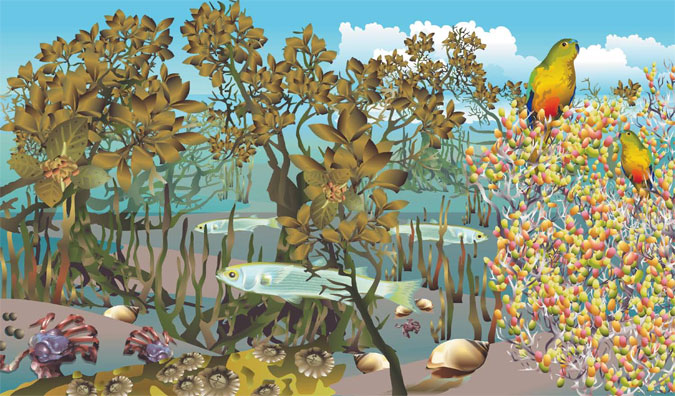Saltmarshes and Mangroves poster

In coastal areas periodically flooded by seawater, communities of salt tolerant plants called saltmarshes can develop. The remaining saltmarshes are vitally important habitats for rare animals and plants including the highly endangered Orange Bellied Parrot.
Victoria also has mangroves. These small trees are capable of growing between the tides in thick mud. Mangroves are important as nursery habitat for many fish and crustacean species as well as trapping large amounts of silt and building up mudflats.
Both mangrove and saltmarsh habitats have been viewed as worthless in the past as they are generally areas that are muddy and smelly due to lack of air in the mud and the presence of mosquitoes. Many areas that formerly were covered in saltmarsh or mangroves have been cleared to create housing estates, marinas, resorts, and farmland.
They are challenging habitats for conservation as people find them hard to enjoy. Fortunately Victoria still has a number of sites where these now rare plant communities can be found, such as Western Port Bay.
Key Species

White/Grey Mangrove
(Avicennia marina)
White/Grey mangroves are the only species of mangrove found in southern Australia. They have special features that help them to survive in waterlogged saline mud. Networks of aerial roots called pneumatophores stick up out of
the mud and help the small trees to breathe. Their leaves have salt glands that allow them to excrete excess salt. Mangrove seeds float and are well developed allowing them to quickly establish themselves when lodged in mud.

Mangrove Algae
(Various species)
The various species of algae that grow on the pneumatophores and trunks of mangroves are an important food source for grazing animals like snails that live in the mangrove community. There are a number of species of algae that are
unique to mangroves, some form dense, stringy mats that almost completely cover the mangrove roots.

Glassworts
(Various species)
Glassworts have small succulent leaves that store water. This enables them to cope with the salty soils in which they live. Lower leaves are filled with salts and turn reddish as the plants mature and fall off, removing excess salt. Previously
Glassworts were burnt to produce ash used in glassmaking.

Orange Bellied Parrot
(Neophema chrysogaster)
One of Australia's most endangered species the Orange Bellied Parrot is dependent on saltmarsh habitat for food during their winter visits to southern Australia. There are now only around 200 birds remaining in the wild.
Protection of remaining saltmarsh habitat is vital to prevent the extinction of this beautiful bird.

Moon Snail
(Polinices conicus)
These large snails live near the surface of the mud and actively seek out bivalves that are their prey. Using their scraping tongues, moon snails drill holes through the shell of their prey and feed on the meat inside. Many people will
be familiar with their large horseshoe shaped jelly egg masses that sometimes appear on beaches in large numbers.

Barnacles
(Elminius spp.)
Capable of surviving out of the water when the tide recedes, barnacles are crustaceans that attach themselves to the roots of mangroves and other surfaces. The shells of barnacles have two plate like valves that seal the animals inside. When
covered by the tide, the valves are opened and the barnacles capture food using specialised feet that strain the water.

Soldier Crab
(Mictyris platycheles)
Often forming large "armies" that emerge from the mud as the tide recedes, soldier crabs are scavengers that feed on organic material that lies on the surface of the mud. As they sift through the sediment, leftover mud material
is rolled in small balls that cover the mudflats. When disturbed or when the mud dries out the crabs spiral themselves downwards and await the next receding tide.

Yellow-Eye Mullet
(Aldrichetta forsteri)
A popular species for recreational fishers, mullet spend much of their time living in bays and estuaries and around mangroves. Adult mullet are largely scavengers feeding mainly on organic material whereas younger fish feed
on plankton or small animals dwelling on the ocean floor. Many species of fish use mangrove habitats as nursery areas.
Habitat Close Up
Mangrove Food Cycle
In mangrove communities sunlight energy is trapped by the mangrove trees through the process of photosynthesis. Leaves falling from the trees into the water are attacked by many bacteria and other microbes which break the leaves down into particles of organic material. This material represents a major food source for other animals living in the mangrove community and is referred to as detritus.
There are a large number of species that feed directly on detritus. Worms in the sediment take in large amounts of sediment and digest the detritus for their own needs. Crabs and shrimp also consume large quantities of the detritus and sift through the sediment to obtain their food requirements. Filter feeding animals that live attached to the mangrove trunks or pneumatophores such as barnacles and mussels can also use the detritus in the water as an energy source. Some fish, like mullet, also feed on organic material in the water.
These animals become food for other larger animals. Wader birds such as egrets feeding on the exposed mudflats will seek out shrimp and crabs. Other birds with suitable beaks such as spoonbills or ibis will dig down deep into the mud looking for worms. Filter feeding molluscs like mussels and pippies become food for birds like oystercatchers that have strong beaks for breaking through shells. Larger fish move under the mangroves when the tide comes in looking for invertebrates like crabs or shrimp, as well as eating smaller fish.
Mangroves are also important because they trap silt washing down rivers and prevent it from reaching and smothering rocky reefs and seagrass beds. They also protect the banks of estuaries from erosion, caused by the wake from boats moving through the water, by absorbing the energy from the waves.
For more information or to visit some of these magnificent marine habitats, please contact the:
Marine and Freshwater Discovery Centre, Queenscliff
Ph: 03 5258 3344
Email: marine.discovery@vfa.vic.gov.au
